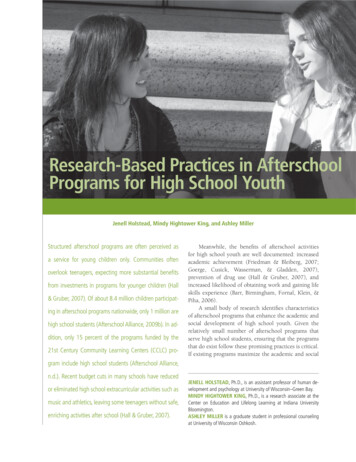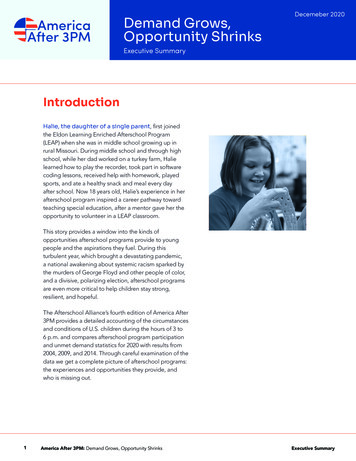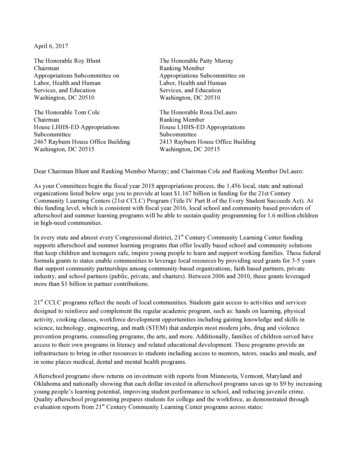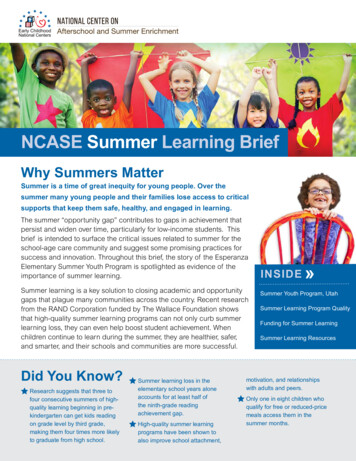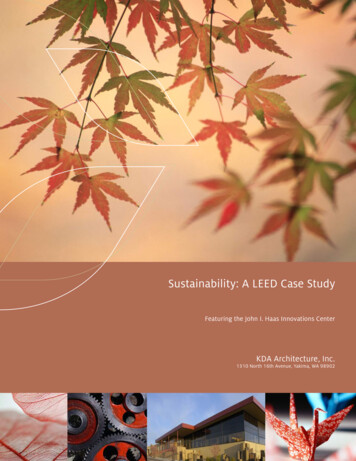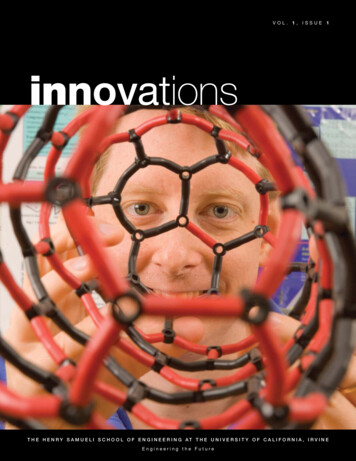
Transcription
Afterschool Innovations in BriefFocusing on Middle School Age YouthProviding Multiple Benefits to Middle School StudentsMiddle School and Science, Technology, Engineering and Math (STEM)Key to Health and Wellness for Pre-teens and TeensSupporting Career and College Pathways for Middle School Age YouthJanuary 2011
Afterschool Innovations in Brief:Engaging Middle School YouthMiddle school is widely recognized as a pivotal time for young people. Afterschool programsare a proven strategy for putting young people on the path to success; however, far too manymiddle school youth do not have access to high quality programs after school. MetLifeFoundation is pleased to join the Afterschool Alliance in recognizing and sharing exemplarymodels of afterschool programs that work with middle school youth and help them catch up,keep up and get ahead in school and life.--Dennis White, president and CEO of MetLife FoundationThe middle school years are a crucial juncture in young people’s lives during whichthey go through several important developmental changes and form behaviors thatwill greatly affect their future. Students in grades 6-8 face unfamiliar experiencesunder a newfound independence that can lead them toward a life filled with eitherachievement or tribulation. Fortunately, many middle schoolers are establishingpaths leading toward success with the help of proven, effective afterschoolprograms. The 1.4 million children in grades 6-8 who benefit from afterschoolprograms show their immense impact on academic and social development.However, millions of other middle schoolers have no afterschool programs availableto them. Right now, more than 3.7 million middle school children are unsupervisedafter the school day ends, while another 3 million children would attend anafterschool program if one were available to them. The supply of these beneficialprograms is not meeting the demand.Afterschool programs for middle school students are a prime example of themultiple benefits youth of all ages can gain through learning experiences outside theclassroom. Whether through supplying middle schoolers with homework help,science learning, opportunities for recreation or paths to higher education, thepotential impact of afterschool programs goes far beyond the widely recognizedbenefit of providing safe, supervised environments in the hours after school.Despite the effectiveness of these programs, the economy and limited funding haveforced local communities to make difficult choices about how to use afterschoolresources, often leaving middle school youth with few options.Our nation needs to expand afterschool programming so that it is available to everychild who needs it, especially those in the critical middle grades. The best way torealize growth is to educate leaders, funders, media and the public about the manybenefits afterschool programs offer. This compendium pulls together both researchand promising programs that demonstrate the wide range of outcomes affected byafterschool, illustrating how afterschool programs help middle school youth,families and communities.www.afterschoolalliance.org1
With support from MetLife Foundation, the Afterschool Alliance is proud to presentthis series of four Issue Briefs examining critical issues facing middle school youth,schools and communities, and the vital role afterschool programs play in addressingthese issues. The four briefs address: the multiple benefits of afterschool for middleschool youth; Science, Technology, Math and Engineering (STEM); health andwellness for pre-teens and teens; and pathways to higher education and careers.Each brief combines relevant statistics, comments from experts and communityleaders and examples of outstanding afterschool programs.Through a competitive awards process that identified highly effective and lesserknown programs and models, six afterschool programs nationwide were named2010 MetLife Foundation Afterschool Innovators. In addition to being highlighted inone of the four briefs, each of the MetLife Foundation Afterschool Innovatorsreceived a 5,000 award to sustain and expand their work.Below is a brief summary of each of the four Issue Briefs and a description of the sixMetLife Foundation Afterschool Innovators. The full text of each brief is included inthis compendium and can also be found on the Afterschool Alliance hIssueBriefs.cfmAfterschool: Providing Multiple Benefits for Middle SchoolStudentsStudents in middle school face unique challenges as they transition from elementaryschool to high school. Some youth feel ready for moreindependence and autonomy, while others still desire“We use visual arts, music,the structured and nurturing environment found indance, theater arts and theelementary school. Regardless of where a youngwritten word to engage ourperson may be developmentally, these years arestudents in creative pursuits,critical for keeping them engaged in school. Mostacademic learning, violenceprevention and communitystudents are too young to work, yet feel thatservice. Our program hasafterschool programs are designed for youngerincreasedthe students’ in-schoolchildren and are unwilling to participate. But middleattendance and significantlyschool youth still need a safe place to have fun andimproved their academiclearn. Afterschool programs can offer multipleachievement.”benefits to help middle schoolers navigate theadolescent years, thereby preparing them for successJim Pugliese, Director of LeAPin high school, college and beyond.Afterschool at CIS 22 The Learning Through an Expanded Arts Program, Inc. (LeAP) at theJordan L. Mott School CIS 22 in the Bronx, New York serves economicallydisadvantaged and culturally underserved middle school youth, providingafterschool arts-based instruction, community service activities, tutoring andmentoring. The program uses all genres of art as well as the written word toengage students in creative pursuits, academic success and creativewww.afterschoolalliance.org2
development. The program builds students’ art skills, increases theirinvolvement and attendance in school, builds confidence and creativity,prevents violence in school and out and helps students forge positiverelationships with peers and adult role-models. Since LeAP’s inception in2005, CIS 22 has gone from one of the worst schools in the Bronx to one ofNew York City’s best, with dramatic improvements in school attendance ratesand Math and English/Language Arts test scores.Cypress Hills/East New York (CHENY) Beacon afterschool program atIntermediate School 302 in Brooklyn, New York engages middle schoolstudents in a multipronged path to leadership development. In addition tohomework assistance, arts and sports programming and snacks, participantsregister for one of three service groups. In Heirs 2 the Community, studentsdesign and implement a series of three to four service projects in thecommunity. The Intergenerational Services Program engages youth in serviceto local seniors, while Leaders-in-Training offers middle school youth theopportunity to play leadership roles with younger children. All participantswho successfully complete their service group are then eligible for thecounselor-in-training program in the high school. Middle schoolersparticipating in the CHENY Beacon have seen social gains such as increasedindependence, confidence and community engagement.Middle School and Science, Technology, Engineering and Math(STEM)The information economy of the twenty-first century is creating more jobs thatrequire not only a college education, but also at least some expertise in the fields ofscience, technology, engineering and math, collectively known as STEM. In order tostay competitive in the global“It’s so important that our nation’s youthmarketplace and provide our childrengain a solid interest in science,with the best opportunity to succeed, wetechnology, engineering and math if we aremust get more students on the STEMgoing to raise a generation that canpath. Combining STEM learning withcompete in the global marketplace andafterschool programming offers middlebecome engaged citizens. We are proud toschool students a fun, challenging, handsbe part of the national movement to makeonintroduction to the skills they willsure that girls have every opportunity toneed in high school, college and thelearn more about these disciplines andworkplace. STEM afterschool programsdevelop a lifelong interest in them.”for middle school youth give studentsDr. Connie Chow, Executive Director oftime to develop an interest in STEM andThe Science Club for Girlsinspire them to learn.At The Bridge Project in Denver, Colorado, middle school students learnabout renewable energy through hands-on science experiments and thenmake short films explaining how different types of renewable energy workand the benefits of sustainable living. The science curriculum on renewablewww.afterschoolalliance.org3
energy, including the experiments, is provided by the National RenewableEnergy Laboratory. Students enjoy hands-on experiments, such as building asolar oven and wind turbine, which help them understand how renewableenergy operates. For the technology component, students work with stateof-the-art movie-making and editing equipment to create a film which isshared with the wider community. This program allows students to learnabout science and technology and gives them a tangible outcome that can beshared with others. A rigorous evaluation shows that participants haveincreased school attendance, improved grades and increased graduationrates. Students also show significant improvements in school engagement,family support and parental support for education and behavioralexpectations at school.The Science Club for Girls and C.E.L.L.S. in Cambridge, Massachusettsseeks to increase the science literacy and self-confidence of girls. Middleschool students participate in hands-on science clubs in 6th and 7th grades,and in the C.E.L.L.S. (Career Exploration, Leadership and Life Skills) programin the second semester of 7th and 8th grade. The curricula encompass a rangeof STEM topics including astronomy, astronautics, climate change andoceans. These interdisciplinary curricula stress hands-on learning, andculminate in a final, collaborative project. Girls are exposed to a variety ofSTEM fields and the real-world applications of principles and tools related tothese fields. The clubs are guided by undergraduate, graduate, andprofessional women in STEM, who serve as role models, mentors and sourcesof information on STEM careers. Internal outcomes evaluations find thatparticipants have a more positive attitude towards science, are moreconfident in themselves as science students and are more aware of careers inSTEM.Afterschool: The Key to Health and Wellness for Pre-teens andTeensAs middle school students gain independence, they often phase out of organizedsports or other active interests. Many of these students don’t have otheropportunities to engage in regular physical activity, especially if they areunsupervised after school. Additionally,“Too many of our young people arechildren are more autonomous in theiradopting sedentary lifestyles and baddietary decisions, leaving them susceptibleeating habits which will haunt them theto ill-advised food choices. Furthermore,rest of their lives. Our students aremany of these youth are also engaging ingaining a lifelong appreciation ofcigarette smoking, alcohol drinking andphysical fitness, an active lifestyle andother unhealthy behaviors for the firsthealthy eating habits.”time. Afterschool programs provide aCynthia Le Monds – CEO, San Antonioplace for middle school youth to stayYouthCentersphysically active, while also learning tomake positive nutritional and lifestylewww.afterschoolalliance.org4
choices. The San Antonio Youth Centers (SAYC) consist of nine afterschool programsin Texas that utilize funding from the federal and state-supported Carol M. WhitePhysical Education Program to implement a physical education and youthdevelopment curriculum. The centers seek to promote healthy lifestyles,improve academic achievement and foster and develop positive youth selfesteem. Middle schoolers at SAYC participate in at least 45 minutes ofstructured daily physical activities that are both fun and vigorous, includingkarate, swimming, cheerleading and rock-climbing. Additionally, SAYC educateyouth about the dangers of smoking, alcohol and drugs to support healthydecision making. They also offer weekly family Boot Camp sessions to cultivateparental involvement and help ensure that healthy living extends into the home.Students participating in SAYC have shown significant reductions in Body MassIndex and success on statewide standardized tests.Afterschool: Supporting Career and College Pathways for MiddleSchool Age YouthAfterschool programs offer a key opportunity to expose students to highereducation and career path options and to teach them skills that can unlock doors tofuture career prospects. During the afterschool hours, there is time forapprenticeships, guest speakers, college“Interests fostered in middle schoolmentoring and project-based activities thatcan often set young people on a pathare not always available during a school dayto a lucrative and exciting career.focused on the core curriculum. AfterschoolBy exposing our students to theprograms better prepare middle schooleducational and career possibilitiesyouth for high school, college and careers,that exist in architecture,while also keeping them on track andconstruction and engineering, weengaged in school.are helping them develop skills andhave experiences that can help themsucceed in life.”The Junior ACE Program inSacramento, California teachesStephanie Davi-Ercolini , Directormiddle school students about greenof Regional Programs for Junior ACEdesign and introduces them tocareers in the architectural designand construction industries. Students take part in a variety of architectureand engineering classes after school on topics including alternative energy,green plumbing and green land use and design. The goal of Junior Ace is toengage children in the middle school years so that they can go on toparticipate in the ACE Mentoring high school program and later be preparedfor careers in architecture, construction and engineering.These four Issue Briefs examine just a few of the ways afterschool programs supportmiddle school students and their families. Highlighting best practices andshowcasing some of the many exemplary afterschool programs build a powerfulwww.afterschoolalliance.org5
case that afterschool is vital for successful youth, strong communities and healthyfamilies.The Afterschool Alliance is a nonprofit public awareness and advocacy organizationworking to ensure that all children and youth have access to quality afterschool programs.More information is available at www.afterschoolalliance.org.MetLife Foundation was established by MetLife in 1976 to carry on its longstandingtradition of corporate contributions and community involvement. In youth development,MetLife funds initiatives that promote mentoring and provide safe places and constructiveactivities, particularly during out-of-school time. For more information about theFoundation visit www.metlife.org.www.afterschoolalliance.org6
Issue Brief No. 41June 2010Afterschool: Providing Multiple Benefits to Middle School StudentsThe Afterschool Alliance, in partnership with MetLife Foundation, is proud to present thefirst in a series of four issue briefs examining critical issues facing middle school youth and the vital roleafterschool programs play in addressing these issues. These issue briefs feature: the multiple benefits of afterschoolfor middle school youth; STEM; pathways to higher education and careers; and health and wellness for pre-teensand teens. They examine just a few of the ways afterschool programs support middle school youth, families andcommunities.Afterschool programs across the country provide critically needed services to our nation’schildren and families; however, many afterschool providers find it difficult to serve youth oncethey enter middle school. Young adolescents offer afterschool providers a special set ofchallenges which they must overcome in order to attract and retain participants. For example,young adolescents are more autonomous, busier, better able and more likely to articulate specificneeds, and less appeased by activities designed for a general audience. While youth in grades sixthrough eight can clearly benefit from participation in afterschool, programs must recognize theneeds of these youth and employ innovative strategies to attract and keep them engaged.Middle School Youth Have Specific NeedsDevelopmental diversity is the central characteristic of early adolescence. Because of the widevariations in “normal” growth rates during puberty, there may be a six-to-eight-year span inphysical development among any group of young adolescents of the same chronological age. iThis translates to a wide range of challenges, skills and needs – all within the same age group. iiNeeds specific to this age group include: iii Physical activity: Young teens need time to stretch, wiggle and exercise their rapidlygrowing bodies. They also need downtime to relax. Competence and Achievement: Because young teens are extraordinarily self-consciousabout their changing selves, they hunger for chances to do something well and provethemselves. They need to know that what they do is valued by others whom they respect. Self-Definition: Young adolescents need chances to consider what it means to become anadult and to belong to a particular ethnic or cultural group. They need opportunities toexplore their widening world so they can begin to consider themselves as participants insociety. Creative Expression: Opportunities to creatively express thoughts, feelings, interests andabilities help young teens understand and accept themselves. Performing and being exposedto drama, literature and musical works of others help them see that people before them haveexperienced similar thoughts and emotions. Middle school youth can also creatively expressthemselves through sports, different art mediums and other hands-on activities.www.afterschoolalliance.org7
Positive Social Interactions with Peers and Adults: Parents and families remain primarysources of values and affection. Peers offer support, companionship and criticism. Inaddition, adults other than parents have an effect on the lives of young adolescents who areeager to understand the possibilities of adulthood. Young adolescents need relationshipswith adults who are willing to share their own experiences, views, values and feelings. Theseadults also encourage young adolescents to develop positive peer relationships.Structure and Clear Limits: Young adolescents live in a society of rules, and they want toknow and understand their own limits within that system. Clear expectations are crucial tounsure, self-critical young people. Their search for security in a world of conflictingdemands is helped by explicit boundaries that define the areas in which they may legitimatelyexplore. They differ from younger children though, in that they are increasingly capable ofparticipating with adults in framing their own rules and limits.Meaningful Participation: Youth need to participate in activities that shape their lives.Successful events are planned with, not for, young adolescents. As they develop a matureappearance and more sophisticated social and intellectual skills, they want opportunities touse their new talents. By learning that their actions can affect the world around them, theygain a sense of responsibility. Adults can help young adolescents see themselves as citizensby providing opportunities for them to make meaningful contributions to their programs andtheir communities. Adults need to adapt responsibilities to the short-term attention spans ofearly adolescents and to select varied tasks that enlist diverse interests and abilities.Middle School Youth and Their Families Need AfterschoolMost families with children in the U.S. today need some type of afterschool services. Theparents of 28 million children work outside the home. Despite this need, the demand for qualityafterschool programs is far from being met. Nearly 4 million middle school youth (grades sixthrough eight) are unsupervised afterschool. iv The conventional wisdom is that by the timechildren reach middle school, they are old enough to take care of themselves and adultsupervision is not as critical as it was when they were in elementary school. However, if left totheir own devices, these young adolescents might not make the best use of the free time theyhave after school. In spite of the autonomy they may be given, middle school age youth needguidance and adult supervision to help keep them safe, engaged in school, and on the path tosuccess in life.Despite Clear Rewards, Barriers to Participation ExistTypically, young children participate in afterschool programs for the enrichment opportunities aswell as to satisfy their family’s child care needs while parents are at work. However, althoughyoung adolescents need mentoring, enrichment and guidance in a positive social environment,participation in afterschool programs declines when children transition from elementary schoolto middle school. vCommon barriers to afterschool participation by middle school youth include: Disinterest/ Boredom: Twenty-five percent of older youth afterschool participants dropout of their programs within two months citing disinterest in the activities. vi The “Relax” Factor: Sixty-five percent of afterschool nonparticipants say that they preferto simply hang out afterschool rather than extend their learning day. viiwww.afterschoolalliance.org8
Family Responsibilities: Twenty percent of youth not currently participating in anafterschool program report that family responsibilities prevent them from attendingafterschool programs. viiiTransportation: Many youth face difficulties in finding transportation to and fromafterschool facilities. Forty-nine percent of parents of afterschool nonparticipants saythat transportation is the main reason their child does not participate in afterschoolprograms. ixFinancial Constraints: The resources for afterschool programs for older youth simply donot exist in many communities. xFortunately, many programs overcome these hurdles and for those that do, the potential impactgoes far beyond the widely recognized benefit of providing safe, supervised environments in thehours after school. Below we highlight a few of the ways that afterschool benefits middle schoolstudents along with a program that is successfully meeting the needs of middle schoolers.In addition to facing more demanding academics, middle school youth are dealing with thechallenge of meeting social and emotional benchmarks as they transition from elementary tomiddle and middle to high school. Afterschool programs can provide an avenue for helpingstudents successfully navigate these challenges while building skills necessary toward success inthe community and in school. xi Using the LeAP model ofThe Learning Through an Expanded Arts Program,incorporating hands-on, artsInc. (LeAP) at the Jordan L. Mott School CIS 22 in thebased approaches to teaching, andBronx, New York serves economically disadvantaged andextending the standard curriculum,culturally underserved middle school youth, providinghas definitely made a positiveafterschool arts-based instruction, community serviceimpact on student achievement.activities, tutoring, and mentoring. The program uses all– Jim Pugliese – Director, LeAPgenres of art as well as the written word to engage studentsAfterschool at 22in creative pursuits, academic success and creativedevelopment. The program builds students’ art skills;increases their involvement and attendance in school;builds confidence and creativity; prevents violence in school and out; and helps studentsforge positive relationships with peers and adult role-models.Afterschool programs can incorporate leadership opportunities while supporting youngadolescents in academics and in their social/emotional development. Cypress Hills/East New York (CHENY) Beacon afterschool program at IntermediateSchool 302 in Brooklyn, New York engages middle school students in a multipronged pathto leadership development. In addition to homework assistance, arts and sports programmingand snacks, participants register for one of three service groups. In Heirs 2 the Community,students design and implement a series of three to four service projects in the community.Intergenerational Services Program engages youth in service to local seniors. Leaders-inTraining offers middle school youth the opportunity to play leadership roles with youngerchildren. All participants who successfully complete their service groups are then eligible forthe counselor-in-training program in the high school.www.afterschoolalliance.org9
As middle school youth gain more independence, it is important for them to learn to makeresponsible choices for themselves and their community. America SCORES in Chicago, Illinois offers middleschool students soccer, leadership and healthy lifestyletraining, literacy/creative writing workshops; andservice learning activities. The varied components ofthe program reinforce and rely on each other – activeparticipation in all aspects of the program is expectedand required in order to be part of the soccer team.The “poet-athletes” learn to make healthy choices, andlearn firsthand their power to impact their community.I have seen students go from beingvery shy, but once they start theprogram become different people.If the students aren't doing well inclass they now have a motivationto stay on the team.– Coach Dean, AmericaSCORESSuccessful afterschool programs for middle school youth actively engage and empower youth –allowing them to choose which activities to participate in, and how to take advantage of availableresources. The Sunset Neighborhood Beacon Center’s (SNBC)Afterschool Program in San Francisco, California providessocial and academic supports. Each day, students engage inproject-based learning activities (“clubs”) as well as recreationand service learning. Youth in the program choose which clubto join. Examples of clubs include newsletter and moviemaking, cartoon and anime, urban music, peer resources andleadership, urban dance, and flash animation. Clubs integratethe most up-to-date audio, video and computing technology aswell as promote community engagement and leadershipopportunities for maximum youth interest and motivation.Being a parent of a participantof SNBC activities, I see firsthand the positive effects theprograms, activities and staffhave had on my son. SNBC isa true Sunset District gem!– Terry Gutierrez, ParentAfterschool programs can offer critically needed supports during a time of transitions in a youngadolescent’s life. ZONE 3 in Doraville, Georgia, outside of Atlanta, reaches out to middle school minorityyouth from low-income families who are at risk for becoming involved in criminal and/ordangerous behavior in an area known for gang activity. The program aims to not only todecrease exposure to gang activity, but also to increase academic achievement, consciousnessof community issues, knowledge of career and life choice potentials and knowledge ofhuman and civil rights. Youth are provided a safe space to receive tutoring and homeworkassistance, and engage in community service, field trips and enrichment activities.Afterschool programs can offer young adolescents the opportunity to design their own programsand choose enriching activities that allow them to have fun, learn, and give them ownership oftheir out of school time in a safe and supervised environment.www.afterschoolalliance.org10
Teen Recreation Activities Program (TRAP) in Dubois, Wyoming providesenrichment programming for middle school youth every day after school and during thesummer. DuBois is a small rural community with limited available services and only 190school aged youth. TRAP is a direct result of focus group meetings made up of middleschool youth who designed the afterschool program. Activities include a youngentrepreneurs program, STEM programs, and mentoring. Because of the limitedresources available to the community, TRAP provides these youth with criticalexperiences and support that they would not otherwise have.ConclusionMiddle school youth have a unique set of social, emotional and academic needs, and afterschoolsuccessfully weaves these together, using enriching and engaging activities to support the wholechild. Afterschool offers multiple benefits to these young adolescents, but only if the barriers toparticipation are removed, and youth are given the opportunity to meaningfully participate.iNorth Carolina Area Health Education Centers Program: Health Careers and Minority Workforce DevelopmentCouncil (1996). Guide for Working with Adolescents. Preceptor/Mentor Handbook. Chapel Hill.iiKerewsky, W. and Lefstein, L.M. (1982). “Young Adolescents and Their Communities: A Shared Responsibility.”Carrboro. University of North Carolina Press.iiiNorth Carolina Area Health Education Centers Program: Health Careers and Minority Workforce DevelopmentCouncil (1996). Guide for Working with Adolescents. Preceptor/Mentor Handbook. Chapel Hill.ivAfterschool Alliance (2010) America After 3PM. Washington, D.C.vLauver, S., Little, P.M.D., & Weiss, H.B. (July 2004). Moving beyond the barriers: Attracting andsustaining youth participation in out-of-school time programs. Harvard Family Research Project, 6.Retrieved March 21, 2009 from urces/issuebrief6.html.viU.S. Department of Education. (2003). When schools stay open late: The national evaluat
wellness for pre-teens and teens; and pathways to higher education and careers. Each brief combines relevant statistics, comments from experts and community leaders and examples of outstanding afterschool programs. Through a competitive awards process that identified highly effective and lesser-


